belt MAZDA MODEL RX 8 2008 (in English) Owner's Guide
[x] Cancel search | Manufacturer: MAZDA, Model Year: 2008, Model line: MODEL RX 8, Model: MAZDA MODEL RX 8 2008Pages: 432, PDF Size: 8.31 MB
Page 45 of 432
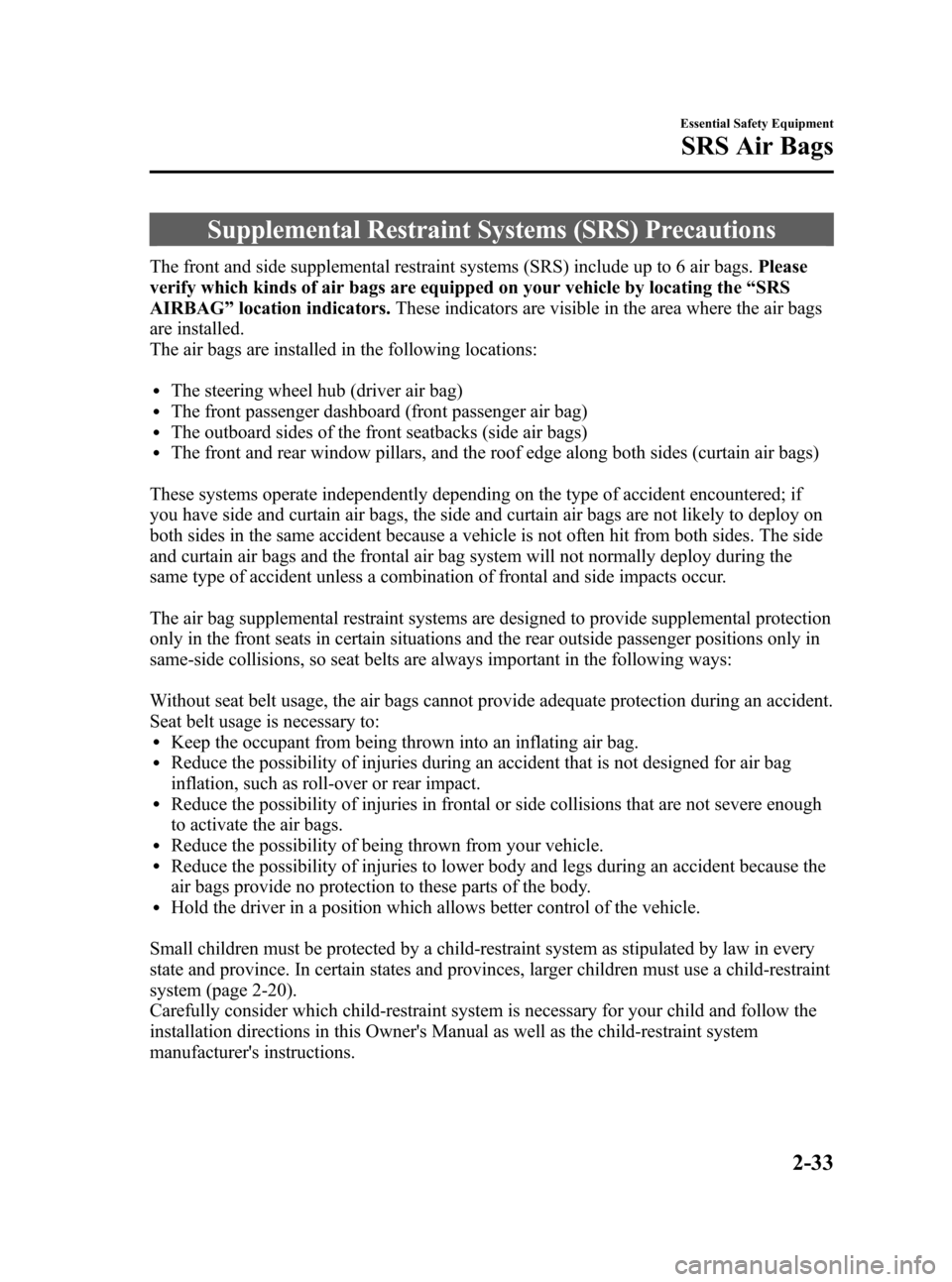
Black plate (45,1)
Supplemental Restraint Systems (SRS) Precautions
The front and side supplemental restraint systems (SRS) include up to 6 air bags.Please
verify which kinds of air bags are equipped on your vehicle by locating the “SRS
AIRBAG ”location indicators. These indicators are visible in the area where the air bags
are installed.
The air bags are installed in the following locations:
lThe steering wheel hub (driver air bag)lThe front passenger dashboard (front passenger air bag)lThe outboard sides of the front seatbacks (side air bags)lThe front and rear window pillars, and the roof edge along both sides (curtain air bags)
These systems operate independently depending on the type of accident encountered; if
you have side and curtain air bags, the side and curtain air bags are not likely to deploy on
both sides in the same accident because a vehicle is not often hit from both sides. The side
and curtain air bags and the frontal air bag system will not normally deploy during the
same type of accident unless a combination of frontal and side impacts occur.
The air bag supplemental restraint systems are designed to provide supplemental protection
only in the front seats in certain situations and the rear outside passenger positions only in
same-side collisions, so seat belts are always important in the following ways:
Without seat belt usage, the air bags cannot provide adequate protection during an accident.
Seat belt usage is necessary to:
lKeep the occupant from being thrown into an inflating air bag.lReduce the possibility of injuries during an accident that is not designed for air bag
inflation, such as roll-over or rear impact.
lReduce the possibility of injuries in frontal or side collisions that are not severe enough
to activate the air bags.
lReduce the possibility of being thrown from your vehicle.lReduce the possibility of injuries to lower body and legs during an accident because the
air bags provide no protection to these parts of the body.
lHold the driver in a position which allows better control of the vehicle.
Small children must be protected by a child-restraint system as stipulated by law in every
state and province. In certain states and provinces, larger children must use a child-restraint
system (page 2-20).
Carefully consider which child-restraint system is necessary for your child and follow the
installation directions in this Owner's Manual as well as the child-restraint system
manufacturer's instructions.
Essential Safety Equipment
SRS Air Bags
2-33
RX-8_8X44-EA-07G_Edition1 Page45
Friday, May 11 2007 5:2 PM
Form No.8X44-EA-07G
Page 46 of 432
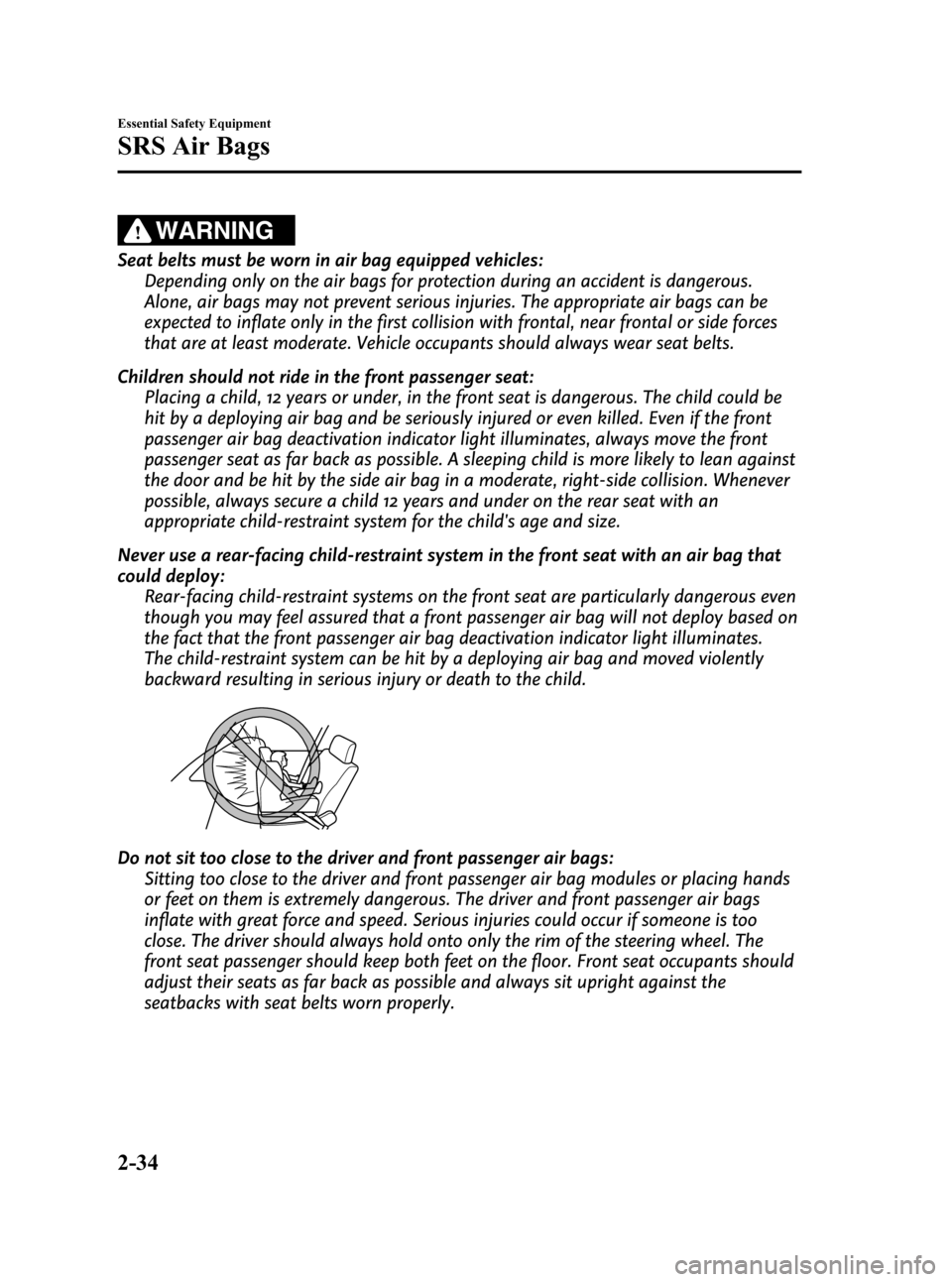
Black plate (46,1)
WARNING
Seat belts must be worn in air bag equipped vehicles:Depending only on the air bags for protection during an accident is dangerous.
Alone, air bags may not prevent serious injuries. The appropriate air bags can be
expected to inflate only in the first collision with frontal, near frontal or side forces
that are at least moderate. Vehicle occupants should always wear seat belts.
Children should not ride in the front passenger seat: Placing a child, 12 years or under, in the front seat is dangerous. The child could be
hit by a deploying air bag and be seriously injured or even killed. Even if the front
passenger air bag deactivation indicator light illuminates, always move the front
passenger seat as far back as possible. A sleeping child is more likely to lean against
the door and be hit by the side air bag in a moderate, right-side collision. Whenever
possible, always secure a child 12 years and under on the rear seat with an
appropriate child-restraint system for the child's age and size.
Never use a rear-facing child-restraint system in the front seat with an air bag that
could deploy: Rear-facing child-restraint systems on the front seat are particularly dangerous even
though you may feel assured that a front passenger air bag will not deploy based on
the fact that the front passenger air bag deactivation indicator light illuminates.
The child-restraint system can be hit by a deploying air bag and moved violently
backward resulting in serious injury or death to the child.
Do not sit too close to the driver and front passenger air bags:Sitting too close to the driver and front passenger air bag modules or placing hands
or feet on them is extremely dangerous. The driver and front passenger air bags
inflate with great force and speed. Serious injuries could occur if someone is too
close. The driver should always hold onto only the rim of the steering wheel. The
front seat passenger should keep both feet on the floor. Front seat occupants should
adjust their seats as far back as possible and always sit upright against the
seatbacks with seat belts worn properly.
2-34
Essential Safety Equipment
SRS Air Bags
RX-8_8X44-EA-07G_Edition1 Page46
Friday, May 11 2007 5:2 PM
Form No.8X44-EA-07G
Page 47 of 432

Black plate (47,1)
Sit in the center of the seat and wear seat belts properly:Sitting too close to the side air bag modules or placing hands on them is extremely
dangerous. The side air bags inflate with great force and speed directly out of the
outboard side of the front seat and expand along the front door on the side the car is
hit. Serious injury could occur if someone is sitting too close to the door or leaning
against a window, or if rear seat occupants grab the sides of the front seatbacks.
Furthermore, sleeping up against the door or hanging out the windows in the vehicle
could block the side and curtain air bags and eliminate the advantages of
supplemental protection. Give the side and curtain air bags room to work by sitting
in the center of the seat while the vehicle is moving with seat belts worn properly.
Do not attach objects on or around the area where driver and front passenger air
bags deploy: Attaching an object to the driver and front passenger air bag modules or placing
something in front of them is dangerous. In an accident, an object could interfere
with air bag inflation and injure the occupants.
Do not attach objects on or around the area where a side air bag deploys: Attaching things to the front seat in such a way as to cover the outboard side of the
seat in any way is dangerous. In an accident the object could interfere with the side
air bag, which inflates from the outboard side of the front seats, impeding the added
protection of the side air bag system or redirecting the air bag in a way that is
dangerous. Furthermore, the bag could be cut open releasing the gas.
Do not hang net bags, map pouches or backpacks with side straps on the front
seats. Never use seat covers on the front seats. Always keep the side air bag modules
in your front seats free to deploy in the event of a side collision.
Do not attach objects on or around the area where a curtain air bag deploys: Attaching objects to the areas where the curtain air bag activates such as on the
windshield glass, side door glass, front and rear window pillars and along the roof
edge and assist grips is dangerous. In an accident the object could interfere with the
curtain air bag, which inflates from the front and rear window pillars and along the
roof edge, impeding the added protection of the curtain air bag system or redirecting
the air bag in a way that is dangerous. Furthermore, the bag could be cut open
releasing the gas.
Do not place hangers or any other objects on the assist grips. When hanging clothes,
hang them on the coat hook directly. Always keep the curtain air bag modules free
to deploy in the event of a side collision.
Do not place luggage or other objects under the front seats: Placing luggage or other objects under the front seats is dangerous. The components
essential to the supplemental restraint system could be damaged, and in the event of
a side collision, the appropriate air bags may not deploy, which could result in death
or serious injury. To prevent damage to the components essential to the
supplemental restraint system, do not place luggage or other objects under the front
seats.
Essential Safety Equipment
SRS Air Bags
2-35
RX-8_8X44-EA-07G_Edition1 Page47
Friday, May 11 2007 5:2 PM
Form No.8X44-EA-07G
Page 50 of 432

Black plate (50,1)
qFront Air Bag System Components
(1)
(7) (11) (8) (7)
(10) (6)
(5)
(4)
(2)
(9)
(3)
(1) Driver seat slide position sensor (page 2-40)
(2) Front seats
(3) Air bag/front seat belt pretensioner system warning light (page 2-49)
(4) Front dual stage inflators and air bags
(5) Front air bag sensor
(6) Front passenger air bag deactivation indicator light (page 2-40)
(7) Front seat belt pretensioner and load limiting systems (page 2-14)
(8) Front passenger seat weight sensors (page 2-40)
(9) Front passenger seat weight sensor control module
(10) Crash sensors and diagnostic module (SAS unit)
(11) Driver and front passenger seat belt buckle switches (page 2-40)
2-38
Essential Safety Equipment
SRS Air Bags
RX-8_8X44-EA-07G_Edition1 Page50
Friday, May 11 2007 5:2 PM
Form No.8X44-EA-07G
Page 51 of 432

Black plate (51,1)
qSide and Curtain Air Bag System Components
(2)
(3)
(4)
(2)
(5)
(1)
(1) Air bag/front seat belt pretensioner system warning light (page 2-49)
(2) Side and curtain inflators and air bags
(3) Front seats
(4) Side crash sensor
(5) Crash sensors and diagnostic module (SAS unit)
Essential Safety Equipment
SRS Air Bags
2-39
RX-8_8X44-EA-07G_Edition1 Page51
Friday, May 11 2007 5:2 PM
Form No.8X44-EA-07G
Page 52 of 432
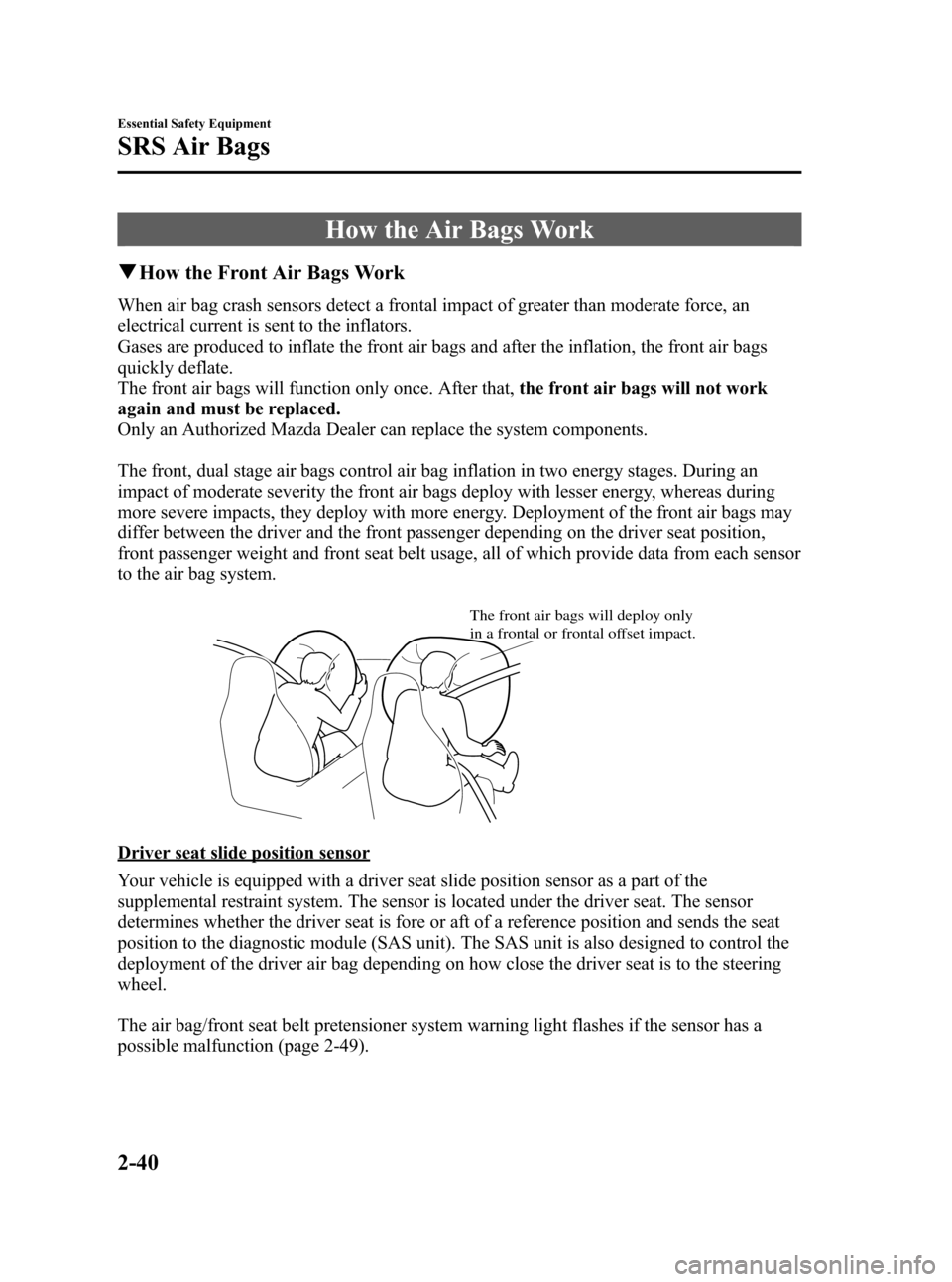
Black plate (52,1)
How the Air Bags Work
qHow the Front Air Bags Work
When air bag crash sensors detect a frontal impact of greater than moderate force, an
electrical current is sent to the inflators.
Gases are produced to inflate the front air bags and after the inflation, the front air bags
quickly deflate.
The front air bags will function only once. After that, the front air bags will not work
again and must be replaced.
Only an Authorized Mazda Dealer can replace the system components.
The front, dual stage air bags control air bag inflation in two energy stages. During an
impact of moderate severity the front air bags deploy with lesser energy, whereas during
more severe impacts, they deploy with more energy. Deployment of the front air bags may
differ between the driver and the front passenger depending on the driver seat position,
front passenger weight and front seat belt usage, all of which provide data from each sensor
to the air bag system.
The front air bags will deploy only
in a frontal or frontal offset impact.
Driver seat slide position sensor
Your vehicle is equipped with a driver seat slide position sensor as a part of the
supplemental restraint system. The sensor is located under the driver seat. The sensor
determines whether the driver seat is fore or aft of a reference position and sends the seat
position to the diagnostic module (SAS unit). The SAS unit is also designed to control the
deployment of the driver air bag depending on how close the driver seat is to the steering
wheel.
The air bag/front seat belt pretensioner system warning light flashes if the sensor has a
possible malfunction (page 2-49).
2-40
Essential Safety Equipment
SRS Air Bags
RX-8_8X44-EA-07G_Edition1 Page52
Friday, May 11 2007 5:2 PM
Form No.8X44-EA-07G
Page 53 of 432

Black plate (53,1)
Front passenger seat weight sensors
Your vehicle is equipped with the front passenger seat weight sensors (page 2-27). These
sensors are located under both of the front passenger seat rails. These sensors determine the
total seated weight on the front passenger seat. The SAS unit is designed to prevent the
front passenger front and side air bags and seat belt pretensioner system from deploying if
the total seated weight is less than approximately 30 kg (66 lb).
To reduce the chance of injuries caused by deployment of the front passenger air bag, the
system deactivates the front passenger front and side air bags and also the seat belt
pretensioner system when:
lThere is no passenger in the front passenger seat. (The front passenger air bag
deactivation indicator light does not illuminate.)
lThe total seated weight on the front passenger seat is less than approximately 30 kg (66
lb). (The front passenger air bag deactivation indicator light illuminates.)
This system shuts off the front passenger front and side air bags and seat belt pretensioner
system, so make sure the front passenger air bag deactivation indicator light illuminates
according to the following table.
The air bag/front seat belt pretensioner system warning light flashes and the front
passenger air bag deactivation indicator light illuminates if the sensors have a possible
malfunction. If this happens, the front passenger front and side air bags and seat belt
pretensioner system will not deploy.
Front passenger air bag deactivation indicator light
This indicator light illuminates to remind you that the front passenger front and side air
bags and seat belt pretensioner will not deploy during a collision.
If the front passenger weight sensors are working properly, the indicator light illuminates
when the ignition switch is turned to the ON position. After a specified period of time it
goes out.
Essential Safety Equipment
SRS Air Bags
2-41
RX-8_8X44-EA-07G_Edition1 Page53
Friday, May 11 2007 5:2 PM
Form No.8X44-EA-07G
Page 54 of 432
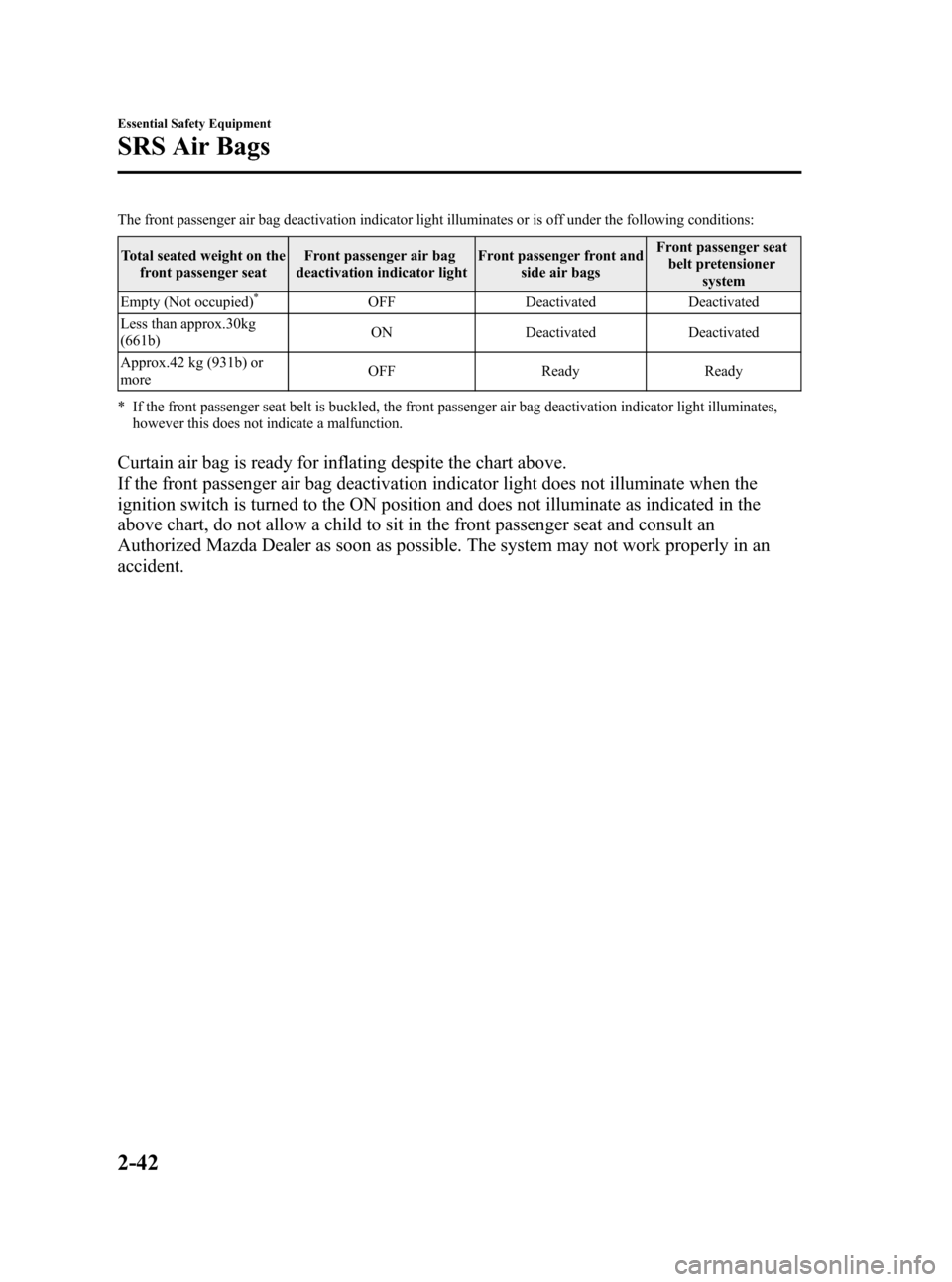
Black plate (54,1)
The front passenger air bag deactivation indicator light illuminates or is off under the following conditions:Total seated weight on the front passenger seat Front passenger air bag
deactivation indicator light Front passenger front and
side air bags Front passenger seat
belt pretensioner
system
Empty (Not occupied)
*OFF Deactivated Deactivated
Less than approx.30kg
(661b) ON
Deactivated Deactivated
Approx.42 kg (931b) or
more OFF
ReadyReady
* If the front passenger seat belt is buckled, the front passenger air bag deactivation indicator light illuminates, however this does not indicate a malfunction.
Curtain air bag is ready for inflating despite the chart above.
If the front passenger air bag deactivation indicator light does not illuminate when the
ignition switch is turned to the ON position and does not illuminate as indicated in the
above chart, do not allow a child to sit in the front passenger seat and consult an
Authorized Mazda Dealer as soon as possible. The system may not work properly in an
accident.
2-42
Essential Safety Equipment
SRS Air Bags
RX-8_8X44-EA-07G_Edition1 Page54
Friday, May 11 2007 5:2 PM
Form No.8X44-EA-07G
Page 55 of 432
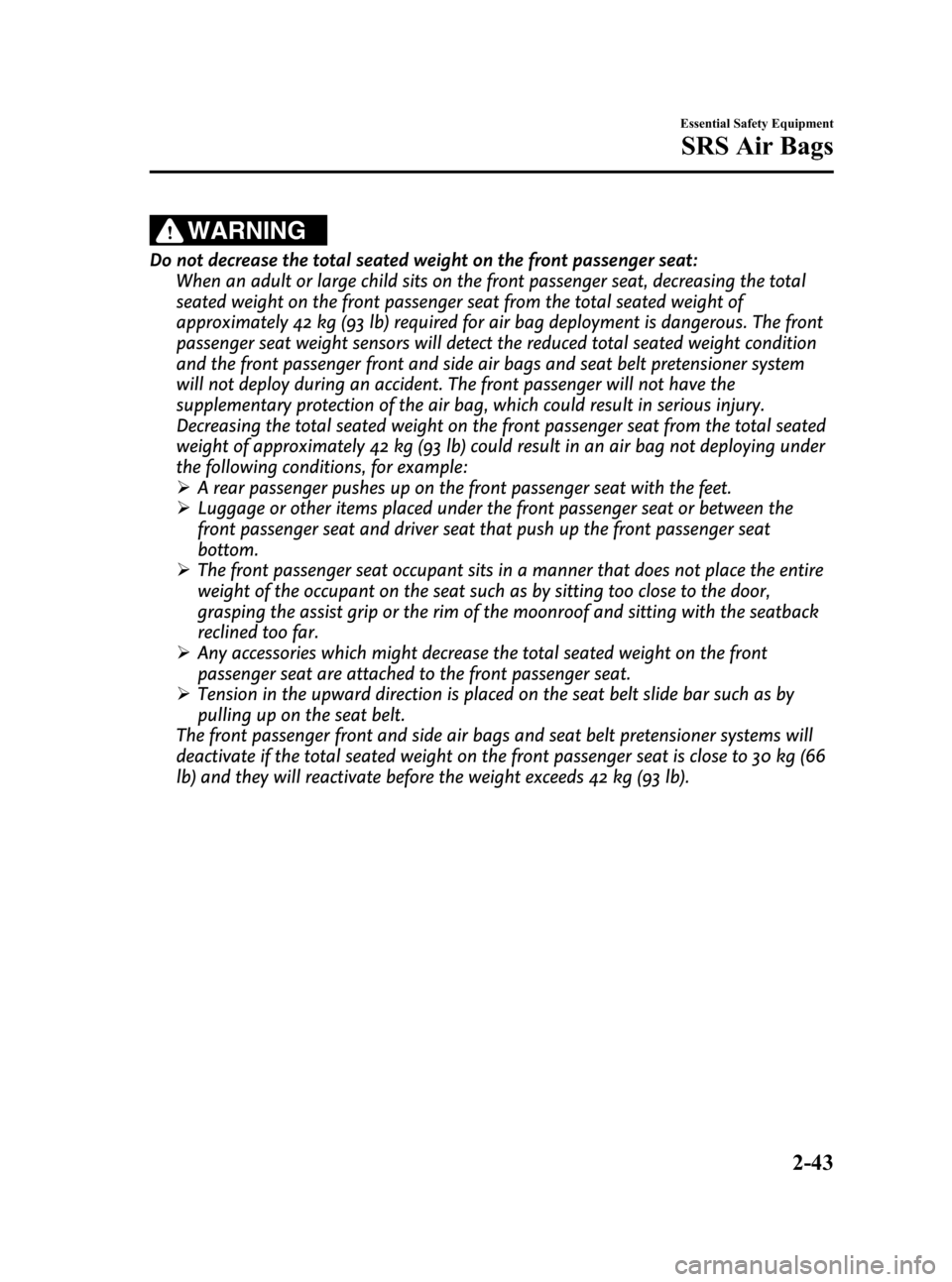
Black plate (55,1)
WARNING
Do not decrease the total seated weight on the front passenger seat:When an adult or large child sits on the front passenger seat, decreasing the total
seated weight on the front passenger seat from the total seated weight of
approximately 42 kg (93 lb) required for air bag deployment is dangerous. The front
passenger seat weight sensors will detect the reduced total seated weight condition
and the front passenger front and side air bags and seat belt pretensioner system
will not deploy during an accident. The front passenger will not have the
supplementary protection of the air bag, which could result in serious injury.
Decreasing the total seated weight on the front passenger seat from the total seated
weight of approximately 42 kg (93 lb) could result in an air bag not deploying under
the following conditions, for example:
ØA rear passenger pushes up on the front passenger seat with the feet.
Ø Luggage or other items placed under the front passenger seat or between the
front passenger seat and driver seat that push up the front passenger seat
bottom.
Ø The front passenger seat occupant sits in a manner that does not place the entire
weight of the occupant on the seat such as by sitting too close to the door,
grasping the assist grip or the rim of the moonroof and sitting with the seatback
reclined too far.
Ø Any accessories which might decrease the total seated weight on the front
passenger seat are attached to the front passenger seat.
Ø Tension in the upward direction is placed on the seat belt slide bar such as by
pulling up on the seat belt.
The front passenger front and side air bags and seat belt pretensioner systems will
deactivate if the total seated weight on the front passenger seat is close to 30 kg (66
lb) and they will reactivate before the weight exceeds 42 kg (93 lb).
Essential Safety Equipment
SRS Air Bags
2-43
RX-8_8X44-EA-07G_Edition1 Page55
Friday, May 11 2007 5:2 PM
Form No.8X44-EA-07G
Page 56 of 432
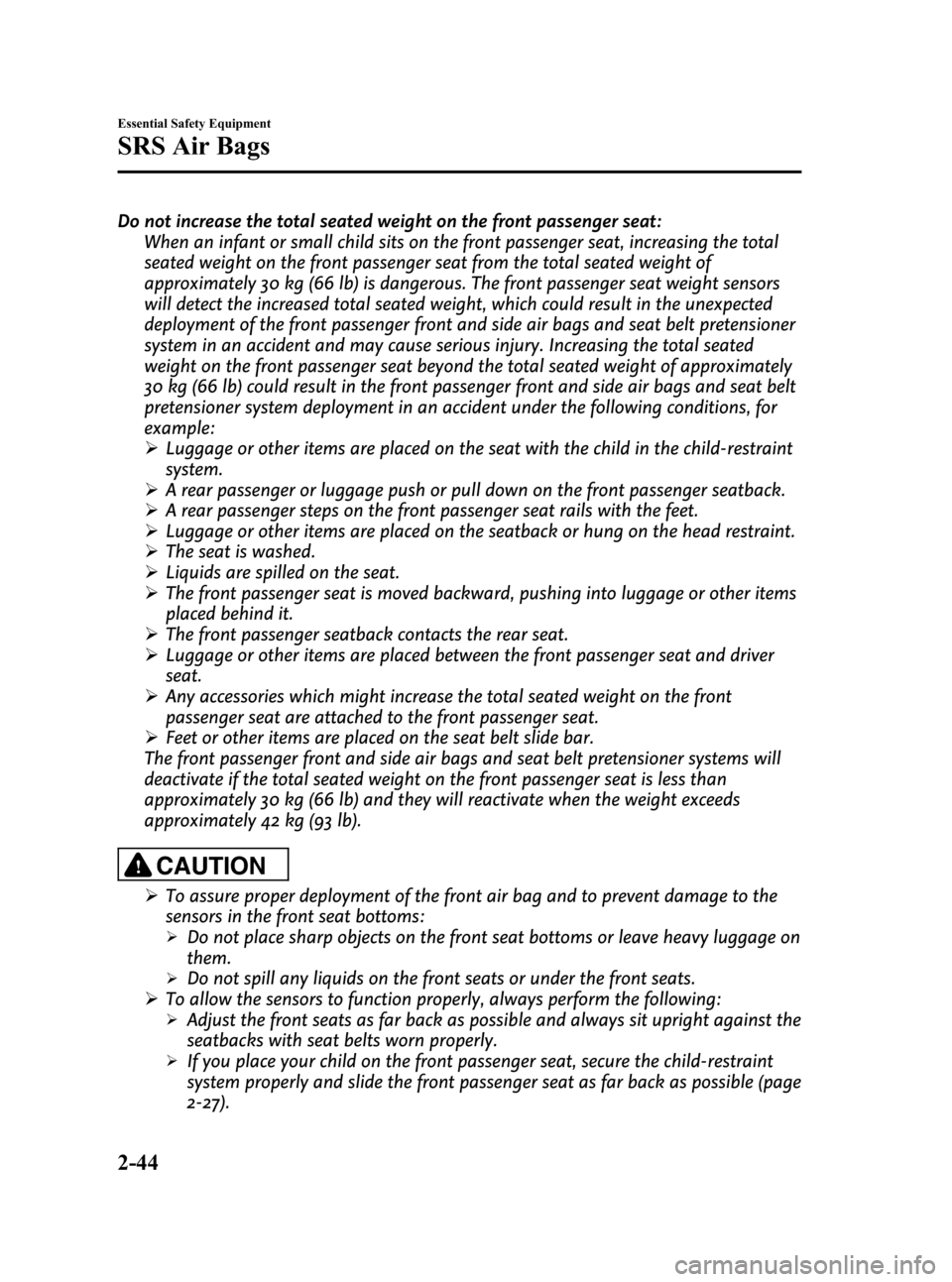
Black plate (56,1)
Do not increase the total seated weight on the front passenger seat:When an infant or small child sits on the front passenger seat, increasing the total
seated weight on the front passenger seat from the total seated weight of
approximately 30 kg (66 lb) is dangerous. The front passenger seat weight sensors
will detect the increased total seated weight, which could result in the unexpected
deployment of the front passenger front and side air bags and seat belt pretensioner
system in an accident and may cause serious injury. Increasing the total seated
weight on the front passenger seat beyond the total seated weight of approximately
30 kg (66 lb) could result in the front passenger front and side air bags and seat belt
pretensioner system deployment in an accident under the following conditions, for
example:
ØLuggage or other items are placed on the seat with the child in the child-restraint
system.
Ø A rear passenger or luggage push or pull down on the front passenger seatback.
Ø A rear passenger steps on the front passenger seat rails with the feet.
Ø Luggage or other items are placed on the seatback or hung on the head restraint.
Ø The seat is washed.
Ø Liquids are spilled on the seat.
Ø The front passenger seat is moved backward, pushing into luggage or other items
placed behind it.
Ø The front passenger seatback contacts the rear seat.
Ø Luggage or other items are placed between the front passenger seat and driver
seat.
Ø Any accessories which might increase the total seated weight on the front
passenger seat are attached to the front passenger seat.
Ø Feet or other items are placed on the seat belt slide bar.
The front passenger front and side air bags and seat belt pretensioner systems will
deactivate if the total seated weight on the front passenger seat is less than
approximately 30 kg (66 lb) and they will reactivate when the weight exceeds
approximately 42 kg (93 lb).
CAUTION
Ø To assure proper deployment of the front air bag and to prevent damage to the
sensors in the front seat bottoms:
ØDo not place sharp objects on the front seat bottoms or leave heavy luggage on
them.
ØDo not spill any liquids on the front seats or under the front seats.
Ø To allow the sensors to function properly, always perform the following:
ØAdjust the front seats as far back as possible and always sit upright against the
seatbacks with seat belts worn properly.
ØIf you place your child on the front passenger seat, secure the child-restraint
system properly and slide the front passenger seat as far back as possible (page
2-27).
2-44
Essential Safety Equipment
SRS Air Bags
RX-8_8X44-EA-07G_Edition1 Page56
Friday, May 11 2007 5:2 PM
Form No.8X44-EA-07G